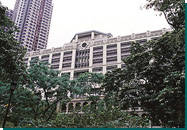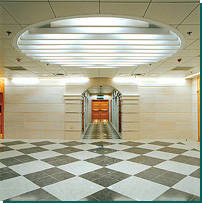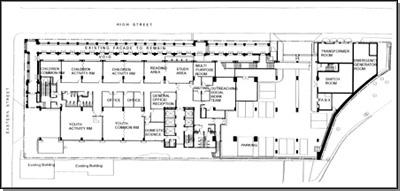| July
2001 |

 |
|
|
Sai
Ying Pun Community Complex
Rehabilitation
Everybody
remembered it as a hospital for lunatics. Then, tales of ghostly
sightings raged to such an extent since it was abandoned in the
1970s that, try though the government did to maintain it in reasonable
condition, it couldn's because no worker would venture inside.
Built in 1891,
the mental hospital in Sai Ying Pun was actually used as nurses'
quarters until the Second World War. It was turned into a mental
hospital after the war and continued to function as such until 1962,
when the completion of Castle Peak Hospital removed the strain of
rising patient numbers. It switched back to outpatient services
until 1971, when operation ceased.
¡@¡@For some years the vacant building became the haunt of curious
teenagers and drug addicts who used the methadone clinic nearby.
It fell into disrepair and was badly burned by two fires believed
to be inadvertently started by trespassers.
 Colonial
architecture Colonial
architecture
Scared away by its association with war, madness and drugs, locals
hardly paid attention to the building's architecture, which is a
blend of 19th century western and traditional Chinese styles. Its
rustic granite facade, with its arched verandah, is reminiscent
of works by well-known 19th century American architect Henry H Richardson.
By contrast, windows with green wooden shutters set in the inner
red brick gave it a Mediterranean feel. Topping all this was a tiled
traditional Chinese roof.
¡@¡@The original north facade had 18 arches with a pediment marking
the middle and turrets at the ends to form a classically proportioned
structure. Six more arches, however, were added during an extension
uphill. The asymmetry arising from its location on the sloping High
Street was skilfully balanced out by the use of a stone plinth to
lift the verandah off the street to present a gradation of rhythm.
¡@¡@The building was the only specimen of its kind in Hong Kong, but
the interior was in a very bad condition after being left vacant
for so long. Fire had destroyed much of it and the roof had collapsed.
Although it would be ideal to preserve the whole building, a compromise
had to be reached. Given its physical condition, it would have been
very costly to restore the whole building, so a decision was reached
to preserve the facade.
¡@¡@The decision was influenced by three factors. First of all, when
the building was built, two-thirds of its cost went into construction
of the arched granite verandah. This was reflected in the attention
and detailing accorded the facade. It was also the only part of
the structure which was assigned Grade 1 status by the Antiquities
Advisory Board, the rest having been judged difficult to maintain
because the wooden structure would be susceptible to rotting. Finally,
the architect considered the superb craftsmanship evident on the
facade. Its preservation would contribute towards the urban space
that surrounded it.
Challenges
to preservation
Except for the old granite facade, therefore, the rest of the old
mental hospital was demolished, to give way to the Sai Ying Pun
Community Complex.
¡@¡@Three options were considered, noted the Architectural Services
Department architects responsible for the project.
¡@¡@One option was to follow the approach of the Peninsula Hotel extension
in using new materials and methods, which nonetheless echoed the
old. The second was to imitate the old by adopting the same design
and materials. The third option was to adopt a design which would
offer a contrast with the old, like IM Pei's pyramid at the Louvre.
¡@¡@The Peninsula approach was eventually chosen as it was considered
the most suitable for the project.
¡@¡@The resulting community complex features a similar architectural
rhythm expressed through modern materials. The fact that reinforced
concrete columns and slab can support larger spans than granite
columns and arches is reflected in the wider spans of the new building.
The scale of the new structure, which is longer and taller, allows
a proportional column grid to be established which also echoes the
rhythm of the old facade.
¡@¡@The bigger building may have dwarfed the historical structure,
but this is avoided by the use of the central lift core to break
down the volume of the new building, by dividing it into two wings.
This treatment also has functional advantages, as it adds flexibility
to the internal layout. The community centre needs this flexibility
to accommodate the many facilities it will contain, which include
an early education training centre on the lower ground floor; group
work unit on the ground floor; elderly homes on the first and second
floors; a community hall; and a children day care centre on the
third floor. There are also facilities for the mentally handicapped
and a singleton hostel on the upper floors.
¡@¡@The lift core is topped by an octagonal metal roof that sets up
a dialogue with the old facade. The scale of the new building is
further broken down by the application of details in the form of
decorative mouldings and window patterns that are neo-classical
in style. The effort to blend the old and the new is also evident
in the use of granite cladding for the east facade, where the entrance
to the community hall is located.
¡@¡@Preserving the facade had its technical difficulties. It affected
the construction of the community complex behind because it stood
in the way of the site access. There was also concern that the facade
might collapse when its derelict portion was being demolished. To
prevent that from happening, the cross walls were demolished in
stages, but this further reduced the amount of room available for
construction of the new building. Both temporary and permanent ties
were also used to hold the facade in place.
¡@¡@Differential settlement was also a potential concern as the facade
stood on a much shallower foundation. Soil nails were installed
on the facade's retaining wall and permanent ties with pivot joints
were used to connect the facade to the new building. Apart from
protective measures, repair work was carried out on the facade itself.
Cracked arches were repaired with steel pins and the original first
floor slab was demolished and replaced with a concrete slab fixed
with resin anchor bars.
Revitalising
a neighbourhood
Careful consideration was given to the type of lighting to be used,
its effect on the building as well as the immediate environs.
¡@¡@Intalling floodlights inside the verandah like the Legislative
Council (Legco) building in Central was considered. However, the
Legco approach presents the building as a showpiece. A more subtle
approach was adopted here, using interior pendant lights along the
gallery and exterior fibre optic lighting to highlight the pediment
and entablature.
¡@¡@The fibre optic lighting is a soft lighting that selectively highlights
each bay. The effect is consistent with the peaceful environment
and the system is relatively cost-effective, compared with floodlights.
It is also less intrusive than other forms of lighting with respect
to installation and glare.
¡@¡@The restored facade now stands quietly in an old neighbourhood
where locals have long become accustomed to its presence. The group
of designers enthused about the prospect of elderly residents emerging
from their rooms for a stroll on the verandah while architecture
buffs came to enjoy the dialogue between the historic facade and
King George V Memorial Park as well as the methadone clinic, which
was also built in the late-19th century.

¡@¡@Sai Ying
Pun is one of the oldest districts in Hong Kong. Until the influx
of developers in the 1980s and '90s, the area was home to a range
of historical public and private structures from which the history
of life in the territory could be traced. The Sai Ying Pun community
centre project has jumpstarted preservation in this pocket of history.
¡@¡@The architects noted that the preservation in Sai Ying Pun Community
Complex has sparked a sense of history, sustainable architecture
and rejuvenation for the district. With the community landmark once
again serving the Hong Kong people, the designers expressed hope
that the area's profile will be raised and its built heritage recognised.
¡@¡@While lamenting the demolition of the neighbouring Euston Castle
(Yue Yuen, a folly on Bonham Road) during the 1980s, one architect
suggested the methadone clinic building could also be restored.
¡@¡@His colleagues nodded in agreement. They knew what they were talking
about -- all three grew up in the area and went to the University
of Hong Kong, further down the road towards Pokfulam.
Architectural
Services Department
architect
Mouchel Asia
structural engineer
Architectural Services Department
e&m engineer
Gammon Construction Ltd
contractor
Architectural Services Department
Quantity surveyor
|

 Colonial
architecture
Colonial
architecture